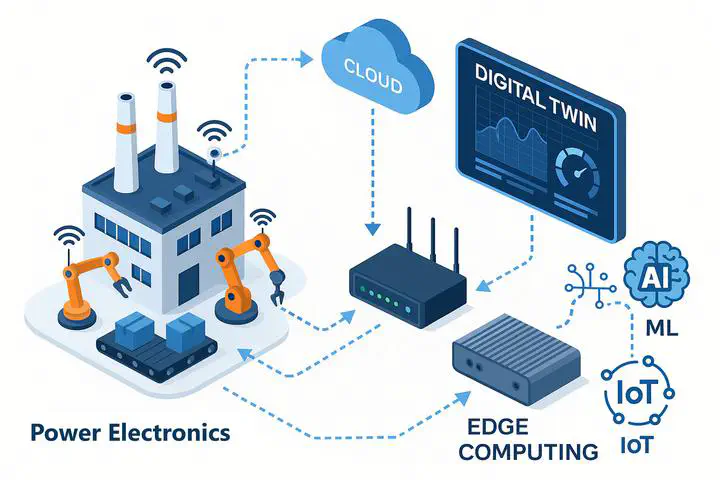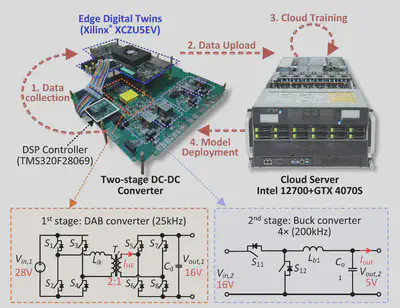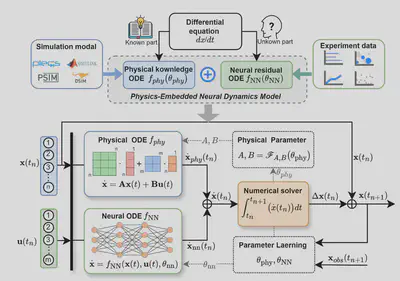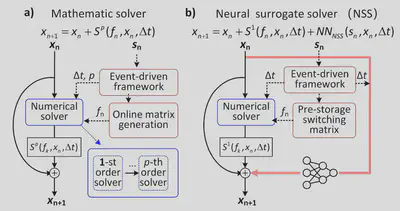Edge Digital Twins for Power Electronics

Overview
This project develops Edge Digital Twins (EDTs) that run next to converters and inverters to deliver low-latency, high-fidelity state inference and control-ready predictions. The core idea is to marry the hybrid physics of power electronics (continuous ODEs + discrete switching events) with neural operators and a cloud-to-edge toolchain, so the twin remains interpretable, fast, and deployable on constrained hardware such as FPGAs and MPSoCs.
Just Ask for questions!
Explore our research with an AI assistant powered by the latest Gemini models and reliable sources to enhance your understanding and analysis.
Why This Research
- Real-time pressure at the edge. High-frequency converters (100 kHz–MHz) impose sub-µs compute budgets; generic sampling-based twins are too slow or too coarse to capture switching events precisely.
- Sim-to-Real gap. Pure physics models drift under unmodeled effects; pure data models need huge datasets and struggle with mode transitions—both hinder trustworthy control integration.
- Hardware constraints. Variable-step high-order solvers are accurate but sequential and time-uncertain on FPGAs; fixed-step solvers are parallel but computationally explosive.
- Control needs visibility. Advanced control (e.g., MPC) benefits from global state without adding sensors or latency; this requires a twin that is accurate, adaptable, and fast at the edge.

Edge Digital Twins Platform
New Measures
- Physics-Embedded Neural ODE (PENODE). Event-aware mode automata drive per-mode continuous-time neural ODEs that inject known ODE primitives as physics priors and learn only residual dynamics. This preserves interpretability, improves data efficiency, and supports adaptive integration.

Physics-Embedded Neural ODE Modeling - Neural Substitute Solver (NSS). A dual-NN design replaces (i) online model updates tied to switching events and (ii) higher-order truncation terms of base integrators—turning sequential bottlenecks into parallel forward passes suitable for FPGA/MPSoC.

Neural Substitute Solver Architecture - Cognitive DT for Control (CDT-MPC). A mode-driven variable-order solver plus LM-based parameter identification yields a reconfigurable numerical twin that supplies sensor-free global states to MPC, enabling dead-beat responses without high-bandwidth probes.
- Cloud-to-Edge toolchain. Quantization, operator fusion, and neural processing units (NPUs) map PENODE/NSS/CDT to edge hardware with consistent real-time guarantees.
Impact
- Speed & resources. Edge inference speedups (e.g., >20×) with >50% compute/resource savings vs. traditional solvers, meeting sub-µs deadlines for high-frequency operation.
- Fidelity & robustness. Physics-guided residual learning improves Sim-to-Real generalization and maintains accuracy across white/gray/black-box regimes; online LM identification tracks parameter drift.
- Control performance. CDT-MPC achieves dead-beat transients, eliminates sensor sampling delays, and expands MPC candidate sets without manual derivations—improving dynamic response and stability margins.
- Deployability. Event-aware scheduling + precomputed per-mode matrices + parallel NN operators enable stable timing on FPGA/MPSoC, easing field integration.
- Generality. Applicable from single converters to multi-port, multi-converter systems; modular design supports future addition of observers, fault diagnosis, and fleet-level coordination.